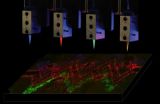(Press-News.org) Washington, DC (February 19 2014) – The lifelong debate of nature versus nurture continues—this time in what your children watch. A recent paper published in the Journal of Communication found that a specific variation of the serotonin-transporter gene was linked to children who engaged in increased viewing of violent TV and playing of violent video games.
Sanne Nikkelen, Helen Vossen, and Patti Valkenburg of the University of Amsterdam's School of Communication Research, in collaboration with researchers at the Erasmus University Medical Centre in Rotterdam, analyzed survey data of 1,612 parents of Dutch children ages 5-9. The parents noted how much violent TV programming their children viewed, as well as how often they played violent video games. DNA samples collected at the children's birth were then analyzed to determine a certain gene variant. The researchers found that children that had the specific variant of the serotonin-transporter gene on average consumed more violent media and displayed more ADHD-related behaviors. However, these links are subtle and more factors can influence these behaviors in children.
Earlier studies have shown that overall amount of media use is partly heritable. These studies, however, did not examine the use of specific media content and did not examine specific gene variants, but only looked at heritability. This study is the first to specifically examine violent media content and to examine a specific gene variant. There have been earlier studies looking at whether violent media use is related to ADHD-related behaviors, but these have found mixed results.
"Our results indicate that children's violent media use is partly influenced by genetic factors. This could mean that children with this gene variant are more likely to seek out stimulating activities, such as violent television viewing and video game playing," said Nikkelen. "It is important to study the relationship between media use and ADHD-related behaviors because children who show increased ADHD-related behaviors often face peer and academic difficulties and are at increased risk for substance abuse. Examining factors that may contribute to the development of these behaviors is essential."
INFORMATION:
"Media Violence and Children's ADHD-Related Behaviors: A Genetic Susceptibility Perspective'" by Sanne Nikkelen, Helen Vossen, Patti Valkenburg, Fleur Velders, Dafna Windhorst, Vincent Jaddoe, Albert Hofman, Frank Verhulst, & Henning Tiemeier, Journal of Communication, Volume 64 No. 1, pgs. 42-60, 2014 doi:10.1111/jcom.12073
Contact: To schedule an interview with the author or a copy of the research, please contact John Paul Gutierrez, jpgutierrez@icahdq.org.
About ICA
The International Communication Association is an academic association for scholars interested in the study, teaching, and application of all aspects of human and mediated communication. With more than 4,300 members in 80 countries, ICA includes 26 Divisions and Interest Groups and publishes the Communication Yearbook and five major, peer-reviewed journals: Journal of Communication, Communication Theory, Human Communication Research, Communication, Culture & Critique, and the Journal of Computer-Mediated Communication. For more information, visit http://www.icahdq.org.
Genetics linked to children viewing high amounts of violent media
Variation of serotonin-transporter gene tied to behavior
2014-02-19
ELSE PRESS RELEASES FROM THIS DATE:
Special air filter blocks small particles called UFPs from getting inside cars
2014-02-19
While taking in the scenery during long road trips, passengers also may be taking in potentially harmful ultrafine particles (UFPs) that come into the car through outdoor air vents. Closing the vents reduces UFPs, but causes exhaled carbon dioxide to build up. Now, scientists report in the ACS journal Environmental Science & Technology that installing a newly developed high-efficiency cabin air filter (HECA) could reduce UFP exposure by 93 percent and keep carbon dioxide levels low.
Yifang Zhu and Eon Lee explain that most modern cars come with cabin air filters, but ...
Kinetic battery chargers get a boost
2014-02-19
New technology to capture the kinetic energy of our everyday movements, such as walking, and to convert it into electrical energy has come a step closer thanks to research to be published in the International Journal Biomechatronics and Biomedical Robotics.
Researchers have for many years attempted to harvest energy from our everyday movements to allow us to trickle charge electronic devices while we are walking without the need for expensive and cumbersome gadgets such as solar panels or hand-cranked chargers. Lightweight devices are limited in the voltage that they ...
A*STAR scientists discover protein's role in human memory and learning functions
2014-02-19
1. Scientists at A*STAR's Institute of Molecular and Cell Biology (IMCB) have identified the precise role of the protein, SNX27, in the pathway leading to memory and learning impairment. The study broadens the understanding of the brain's memory function and could be used to explain defects in the cognitive development of those with Down's syndrome. The newly established knowledge could potentially facilitate exploration of strategies to improve memory and learning abilities in Down's syndrome.
2. Down's syndrome is a genetic condition characterized by the presence ...
Could metabolism play a role in epilepsy?
2014-02-19
VIDEO:
The Kuehner lab demonstrates their drug-screening technique in JoVE's peer-reviewed video format to aid other researchers in the field.
Click here for more information.
February 19—Researchers from the Franciscan University of Steubenville, Ohio are exploring a possible link between metabolic defects and seizures. They determined that diet could influence susceptibility to seizures, and they have identified a common diabetes drug that could be useful in treating disorders ...
An essential step toward printing living tissues
2014-02-19
BOSTON — A new bioprinting method developed at the Wyss Institute for Biologically Inspired Engineering at Harvard University and the Harvard School of Engineering and Applied Sciences (SEAS) creates intricately patterned 3D tissue constructs with multiple types of cells and tiny blood vessels. The work represents a major step toward a longstanding goal of tissue engineers: creating human tissue constructs realistic enough to test drug safety and effectiveness.
The method also represents an early but important step toward building fully functional replacements for injured ...
Antidepressant holds promise in treating Alzheimer's agitation
2014-02-19
Feb. 19, 2014 (Toronto) - An antidepressant medication has shown potential in treating symptoms of agitation that occur with Alzheimer's disease and in alleviating caregivers' stress, according to a multi-site U.S.- Canada study.
"Up to 90 per cent of people with dementia experience symptoms of agitation such as emotional distress, restlessness, aggression or irritability, which is upsetting for patients and places a huge burden on their caregivers," said Dr. Bruce G. Pollock, Vice President of Research at the Centre for Addiction and Mental Health (CAMH), who directed ...
'Beautiful but sad' music can help people feel better
2014-02-19
New research from psychologists at the universities of Kent and Limerick has found that music that is felt to be 'beautiful but sad' can help people feel better when they're feeling blue.
The research investigated the effects of what the researchers described as Self-Identified Sad Music (SISM) on people's moods, paying particular attention to their reasons for choosing a particular piece of music when they were experiencing sadness - and the effect it had on them.
The study identified a number of motives for sad people to select a particular piece of music they perceive ...
Stratification determines the fate of fish stocks in the Baltic Sea
2014-02-19
With its narrow connection to the North Sea, strong currents, a large number of river estuaries and a bottom profile marked by ridges, basins and troughs, the Baltic represents an inland sea with highly different water qualities. The fact that these morphological and hydrographic conditions can also influence the fate of fish stocks has now been shown by a team of fisheries biologists from GEOMAR Helmholtz Centre for Ocean Research Kiel and the National Institute of Aquatic Resources (DTU Aqua) at the Technical University of Denmark. For their publication in the international ...
Dreams, deja vu and delusions caused by faulty 'reality testing'
2014-02-19
New research from the University of Adelaide has delved into the reasons why some people are unable to break free of their delusions, despite overwhelming evidence explaining the delusion isn't real.
In a new paper published in the journal Frontiers in Psychology, University of Adelaide philosopher Professor Philip Gerrans says dreams and delusions have a common link – they are associated with faulty "reality testing" in the brain's higher order cognitive systems.
"Normally this 'reality testing' in the brain monitors a 'story telling' system which generates a narrative ...
A challenge to the genetic interpretation of biology
2014-02-19
A proposal for reformulating the foundations of biology, based on the 2nd law of thermodynamics and which is in sharp contrast to the prevailing genetic view, is published today in the Journal of the Royal Society Interface under the title "Genes without prominence: a reappraisal of the foundations of biology". The authors, Arto Annila, Professor of physics at Helsinki University and Keith Baverstock, Docent and former professor at the University of Eastern Finland, assert that the prominent emphasis currently given to the gene in biology is based on a flawed interpretation ...
LAST 30 PRESS RELEASES:
Sports injuries sustained during your period might be more severe
World's first successful 2 Tbit/s free-space optical communication using small optical terminals mountable on satellites and HAPS
Can intimate relationships affect your heart? New study says ‘yes’
Scalable and healable gradient textiles for multi‑scenario radiative cooling via bicomponent blow spinning
Research shows informed traders never let a good climate crisis go to waste
Intelligent XGBoost framework enhances asphalt pavement skid resistance assessment
Dual-function biomaterials for postoperative osteosarcoma: Tumor suppression and bone regeneration
New framework reveals where transport emissions concentrate in Singapore
NTP-enhanced lattice oxygen activation in Ce-Co catalysts for low-temperature soot combustion
Synergistic interface engineering in Cu-Zn-Ce catalysts for efficient CO2 hydrogenation to methanol
COVID-19 leaves a lasting mark on the human brain
Scientists use ultrasound to soften and treat cancer tumors without damaging healthy tissue
Community swimming program for Black youth boosts skills, sense of belonging, study finds
Specific depressive symptoms in midlife linked to increased dementia risk
An ‘illuminating’ design sheds light on cholesterol
Who is more likely to get long COVID?
Study showcases resilience and rapid growth of “living rocks”
Naval Research Lab diver earns Office of Naval Research 2025 Sailor of the Year
New Mayo-led study establishes practical definition for rapidly progressive dementia
Fossil fuel industry’s “climate false solutions” reinforce its power and aggravate environmental injustice
Researchers reveal bias in a widely used measure of algorithm performance
Alcohol causes cancer. A study from IOCB Prague confirms damage to DNA and shows how cells defend against it
Hidden viruses in wastewater treatment may shape public health risks, study finds
Unlock the power of nature: how biomass can transform climate mitigation
Biochar reshapes hidden soil microbes that capture carbon dioxide in farmland
Reducing saturated fat intake shows mortality benefit, but only in high-risk individuals
Manta rays create mobile ecosystems, study finds
Study: Mixed results in using lipoic acid to treat progressive multiple sclerosis
Norbert Holtkamp appointed director of Fermi National Accelerator Laboratory
New agentic AI platform accelerates advanced optics design
[Press-News.org] Genetics linked to children viewing high amounts of violent mediaVariation of serotonin-transporter gene tied to behavior


